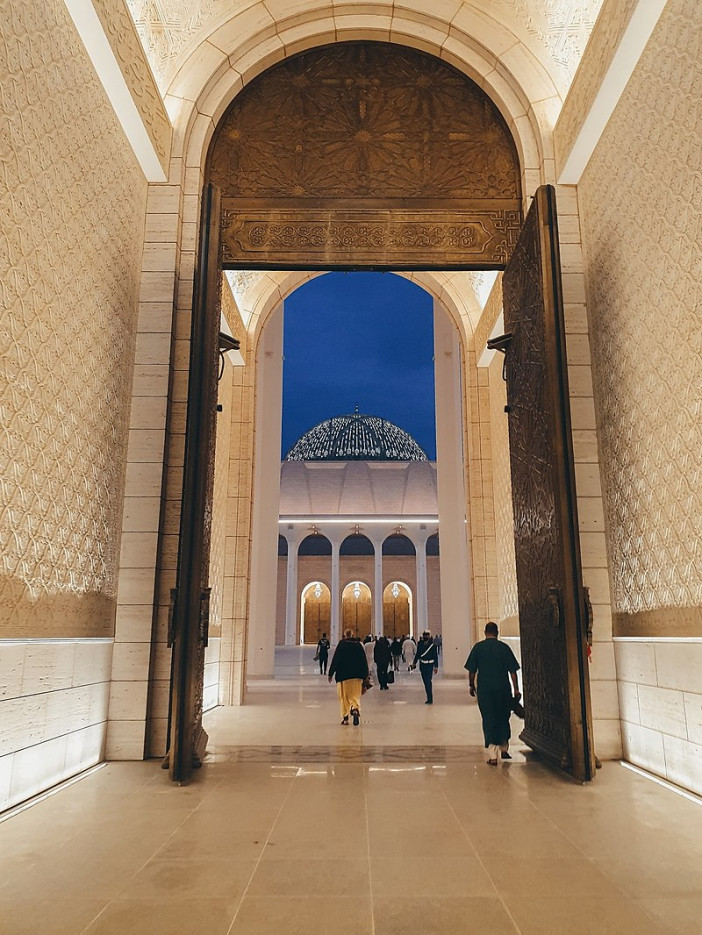Djamaa el Djazaïr
History
After the China State Construction Engineering Corporation was awarded a contract worth 1 billion euros from the Algerian government, work on the mosque officially started in August 2012. The design, which was completed by April 2019, was created by German architects KSP Juergen Engel Architekten and engineers Krebs und Kiefer International. The mosque's construction was delayed due to budgetary issues brought on by the decline in oil prices. The project employed over 2,300 employees from China, Algeria, and other African nations. Many people believed that the building of the mosque represented the long-serving ruler Abdelaziz Bouteflika's rule.
Urban and Architectural
The mosque is situated on a 400,000 m2 (4,300,000 sq ft) plot of land with views of the Mediterranean Sea. The edifice, which includes the compound, can hold up to 120,000 attendees and has space for 7,000 cars in addition to the 37,000 worshipers who can fit in the prayer hall. A Quran(TM) school, a park, a library, a staff housing area, a fire station, a museum of Islamic art, and a study center on the history of Algeria are also located inside the complex.
The mosque also has a 265 m (869 ft) tall minaret, which makes it the tallest building in Africa.
It also houses an observation deck atop the minaret, which has 37 floors. The mosque is designed to withstand an earthquake of magnitude 9.0 and the structure has been specially processed to resist corrosion. The main prayer hall has 618 octagonal columns serving as support pillars and 6 km (3.7 mi) of calligraphic writing engraved with a laser system. The dome of the prayer hall has a diameter of 50 m (160 ft) and rises to a height of 70 m (230 ft).
Description
References
"Africa's largest mosque has been completed with thanks to China". Quartz. Archived from the original on 3 July 2019. Retrieved 30 May 2019
"The Biggest Mosque in Africa is Now in Algeria, Not Morocco". Morocco World News. Archived from the original on 30 May 2019. Retrieved 30 May 2019.
"2019 was record-breaking year for supertall skyscrapers". dezeen.com. 17 Jan 2020. Archived from the original on 26 February 2021. Retrieved 13 June 2021.
"Great Mosque of Algiers: an architectural masterpiece and a religious and cultural monument". Algeria Press Service. Archived from the original on 10 November 2020. Retrieved 30 May 2019.
Details
Location
Algiers, Algeria
Worshippers
157,000 worshippers
Owners
The Algerian government, Ministry of Religious Affairs
Architect Name
Year of Build
29 April 2019
Area
400,000 m2
Drawings
Map
History
After the China State Construction Engineering Corporation was awarded a contract worth 1 billion euros from the Algerian government, work on the mosque officially started in August 2012. The design, which was completed by April 2019, was created by German architects KSP Juergen Engel Architekten and engineers Krebs und Kiefer International. The mosque's construction was delayed due to budgetary issues brought on by the decline in oil prices. The project employed over 2,300 employees from China, Algeria, and other African nations. Many people believed that the building of the mosque represented the long-serving ruler Abdelaziz Bouteflika's rule.
Urban and Architectural
The mosque is situated on a 400,000 m2 (4,300,000 sq ft) plot of land with views of the Mediterranean Sea. The edifice, which includes the compound, can hold up to 120,000 attendees and has space for 7,000 cars in addition to the 37,000 worshipers who can fit in the prayer hall. A Quran(TM) school, a park, a library, a staff housing area, a fire station, a museum of Islamic art, and a study center on the history of Algeria are also located inside the complex.
The mosque also has a 265 m (869 ft) tall minaret, which makes it the tallest building in Africa.
It also houses an observation deck atop the minaret, which has 37 floors. The mosque is designed to withstand an earthquake of magnitude 9.0 and the structure has been specially processed to resist corrosion. The main prayer hall has 618 octagonal columns serving as support pillars and 6 km (3.7 mi) of calligraphic writing engraved with a laser system. The dome of the prayer hall has a diameter of 50 m (160 ft) and rises to a height of 70 m (230 ft).
Description



